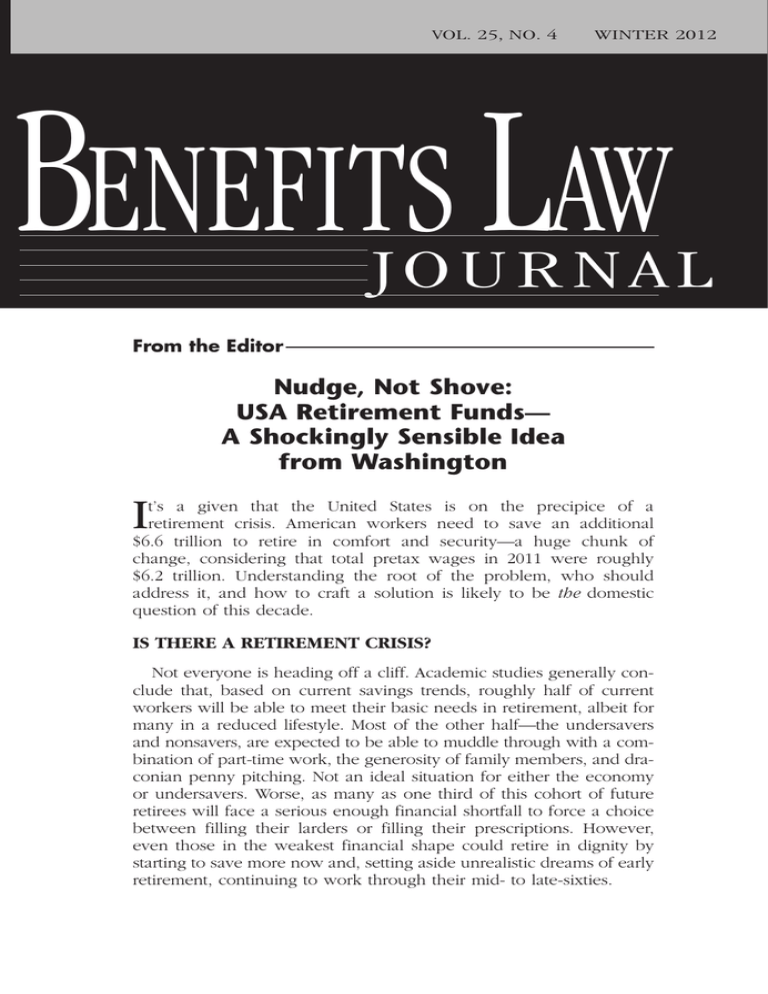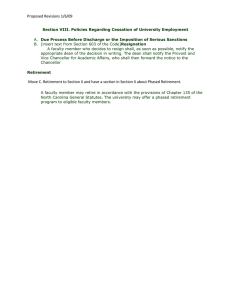
VOL. 25, NO. 4
WINTER 2012
BENEFITS LAW
JOURNAL
From the Editor
Nudge, Not Shove:
USA Retirement Funds—
A Shockingly Sensible Idea
from Washington
I
t’s a given that the United States is on the precipice of a
retirement crisis. American workers need to save an additional
$6.6 trillion to retire in comfort and security—a huge chunk of
change, considering that total pretax wages in 2011 were roughly
$6.2 trillion. Understanding the root of the problem, who should
address it, and how to craft a solution is likely to be the domestic
question of this decade.
IS THERE A RETIREMENT CRISIS?
Not everyone is heading off a cliff. Academic studies generally conclude that, based on current savings trends, roughly half of current
workers will be able to meet their basic needs in retirement, albeit for
many in a reduced lifestyle. Most of the other half—the undersavers
and nonsavers, are expected to be able to muddle through with a combination of part-time work, the generosity of family members, and draconian penny pitching. Not an ideal situation for either the economy
or undersavers. Worse, as many as one third of this cohort of future
retirees will face a serious enough financial shortfall to force a choice
between filling their larders or filling their prescriptions. However,
even those in the weakest financial shape could retire in dignity by
starting to save more now and, setting aside unrealistic dreams of early
retirement, continuing to work through their mid- to late-sixties.
From the Editor
So, how do we get from here to there?
The well-documented causes of the national savings shortfall
include: the demise of company-paid pension plans; the large segment of the working population without access to any kind of employer
retirement plan; and the alarmingly high percentage of workers who
don’t take advantage of their company plan. This has led some pundits to call for requiring that all employers offer and fund a retirement
program. The experience with health care reform should convince
even those folks who think a retirement mandate is a good idea that
this is a nonstarter. Happily, there may be a way to nudge the spenders into preparing for their own financial future without imposing
significant costs on the rest of society. Senator Tom Harkin (D-Iowa)
has proposed a new retirement vehicle for consideration after the
November election. Called USA Retirement Funds, the proposal
requires a limited role by government, only light regulation, and virtually no new requirements on employers—a shockingly sound idea
from Washington. (That’s not to say that Washington has come to its
senses: Senator Harkin’s companion proposal to fix Social Security
would never work.)
USA RETIREMENT FUNDS
USA Retirement Funds is a new type of hybrid pension plan intended, in the proposal’s words, to give workers “the opportunity to earn
a secure benefit” while being “easy for employers to offer.” It aims to
fix two fundamental problems with our current system: (1) workers
don’t save enough for retirement; and (2) employers are turned off by
the complexity, costs, and potential liability of offering a retirement
plan under the current labyrinth of tax and ERISA rules. Here’s what’s
on the table for discussion:
1. Employers that do not offer a 401(k)-type plan with auto
enrollment and a match or a defined benefit plan would
have to make the USA Retirement Funds available. The
employer’s only responsibility for the program would
be selecting one of the available funding vehicles, autoenrolling employees, and processing payroll deductions.
Since every employer already manages income and Social
Security withholding, this would at worst be a minor inconvenience (provided that Congress and the regulators don’t
heap on unnecessary rules that make USA Retirement Fund
withholding more difficult than the regular payroll function).
2. Since all USA Retirement Funds would be licensed and
pre-approved (more on that later), the employer would
have zero liability once the employees’ money goes into
BENEFITS LAW JOURNAL
2
VOL. 25, NO. 4, WINTER 2012
From the Editor
the Fund. That means no responsibly for choosing the right
Fund, worrying whether the money is properly invested, or
if the Fund violated any existing distribution, discrimination,
or other rules. And that means no IRS audits, Form 5500s,
lawyers, consultants, or threats of litigation from disgruntled
participants.
3. The Harkin proposal does mandate a “modest” employer
contribution to the USA Retirement Fund. This would be
a huge mistake. Washington fails to realize that ultimately
the employer contribution has to come from somewhere
and, faced with additional matching or other contributions,
employers would make up the cost by reducing salaries or
hiring fewer workers. For the program to be supported and
successful, employer contributions should be completely
voluntarily.
4. Like a 401(k) plan, workers’ contributions to the USA
Retirement Funds would be tax-deferred until distributed. Taking advantage of the astonishing success of autoenrollment and escalation in increasing savings rates, every
employee would be enrolled at some fixed level (say 6 percent) that would gradually increase each year. Importantly,
participation would be voluntary—the employee could
change his or her contribution rate or opt out at any time.
The proposal does not offer any specifics on the crucial
details of auto enrollment; hopefully, it will aggressively
harness the power of inertia by setting high initial and escalating levels of deferrals and annual reenrollment for folks
contributing nothing or below a minimum level, again with
complete opt-out rights.
5. All contributions would be professionally invested in a
diversified, low-fee USA Retirement Fund. As proposed,
neither employers nor participants would have any fiduciary
responsibility. While employers will certainly relish being
freed from this difficult and sometimes liability-inducing
chore, it’s likely some participants would want a say in
how and where their money is invested, such as a choice
between a more and less conservative investment program.
It will be a difficult, but doable, task of allowing participants
investment flexibility without adding extra administrative
costs or complexities. The last thing we’d need is to recreate the former world of nonprofit employer 403(b) annuity
plans where participants could choose any vehicle that met
their fancy.
BENEFITS LAW JOURNAL
3
VOL. 25, NO. 4, WINTER 2012
From the Editor
6. Payment would be made only as a lifetime pension, plus a
spousal survivor benefit. No lump sums, loans, or hardship
withdrawals. Payments would start at an as-yet undefined
“retirement age,” presumably with early benefits upon disability. Payouts would be based on the employee’s account
balance at retirement (total contributions plus a cash-balance
type crediting rate) and conservative mortality and interest
factors. Clearly, the retirement age should be set at a realistically “older” age like 65. Currently, many people are tempted
to begin receiving Social Security payments at age 62 and
consequently suffer the double whammy of a reduced benefit for early retirement plus they exit the workforce before
they’ve accumulated enough savings. By pooling together a
large number of retirees together, they effectively share the
risk of living “too” long without paying insurance company
mortality charges. Also, the proposal indicates that if the
crediting rate or actuarial assumptions turn out to be too high
or too low, the payments can be slowly adjusted to keep the
Fund in the black.
The one “Big Brother” aspect to the Harkin proposal is the
requirement to take USA Retirement Fund payouts as an annuity. It’s
a good idea that will not only prevent people from spending their
entire fund before retirement but avoid the possibility they will outlive their nest egg. Expect a great deal of pushback on this, because
many people dislike the inflexibility of an annuity. Folks will feel that
they should be able to take their individual account as a lump sum,
viewing it as a pot of money to use as they see fit.
THE FUND ITSELF
The last thing anyone wants is a government bureaucrat managing
their money; instead, think of the model as current 529 college funds,
where competition among the providers has led to low-cost, well-run
programs throughout the country. The funds would be large, professionally managed, and overseen by a board of knowledgeable and
independent fiduciaries. Fees would be low, with perhaps a heavy
emphasis on indexed funds. Each USA Retirement Fund would be
licensed. Crucially, the Funds will be private organizations. Freemarket competition, the ability of employers and participants to
switch funds, and the Fund board’s freedom to switch money managers should lead to an ample number of solid choices. A key element
will be a light regulatory touch for Fund licensing. These requirements should focus on low fees, asset allocation, and low investment
turnover, leaving the details to each fund’s governing board.
BENEFITS LAW JOURNAL
4
VOL. 25, NO. 4, WINTER 2012
From the Editor
STATE GOVERNMENT HELP
Before Senator Harkin released his proposal, another interesting
idea from the National Conference on Public Employee Retirement
Systems (NCPERS) began gaining traction: Secure Choice Pension,
or SCP. This program would permit states to effectively sponsor
a turnkey hybrid pension plan—SCP—that could be voluntarily
adopted by employers. (Full disclosure: my firm assisted NYCPERS
in the design of SCP.) It is targeted at employers that want to help
their employees save for retirement but that are unable or unwilling
to deal with the hassles and unexpected liabilities of the programs
currently available.
Details aside, the key advantage of SCP is that it would leverage
the economies of scale and low-cost investment infrastructure of
existing state and local retirement plans. The SCP funds would be
completely separate from the sponsoring state’s own retirement plan,
thus avoiding any cross liability for the other’s underfunding. Taking
from the USA Retirement and Secure Choice concepts, I could envision a partnership between a state retirement system and a professional recordkeeper as a very effective entrant to the USA Retirement
Fund marketplace.
While nothing is perfect, and there is plenty of room for Washington
to turn a relatively clear and simple concept like USA Retirement
Funds into a regulatory mess, Senator Harkin has done a service in
putting forward a potentially user-friendly program that would nudge
(not shove) workers to prepare for their own retirement—without
imposing major new costs, liabilities, or mandates on employers.
David E. Morse
Editor-in-Chief
K & L Gates LLP
New York, NY
BENEFITS LAW JOURNAL
5
VOL. 25, NO. 4, WINTER 2012
From the Editor
Copyright © 2012 CCH Incorporated. All Rights Reserved.
Reprinted from Benefits Law Journal Winter 2012, Volume 25,
Number 4, pages 1–5, with permission from Aspen Publishers,
Wolters Kluwer Law & Business, New York, NY, 1-800-638-8437,
www.aspenpublishers.com
BENEFITS LAW JOURNAL
6
VOL. 25, NO. 4, WINTER 2012


